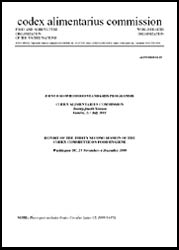
Washington DC, 29 November - 4 December 1999
JOINT FAO/WHO FOOD STANDARDS PROGRAMME
CODEX
ALIMENTARIUS COMMISSION
Twenty-fourth Session
Geneva,
2-7 July 2001
|
CODEX ALIMENTARIUS COMMISSION | |
| FOOD AND AGRICULTURE | WORLD
HEALTH |
|
JOINT OFFICE: Viale delle Terme di Caracalla 00100 ROME Tel.: 39 6 57051 Telex:
625825-625853 FAO I Email: [email protected] Facsimile: 39 06 5705.4593 | |
ALINORM 01/13 E
NOTE: This report includes Codex Circular Letter CL 1999/34-FH
List of Abbreviations used in this Report
Adoption of the Agenda (Agenda Item 1)
Proposed Draft Code of Hygienic Practice for Milk and Milk Products (Agenda Item 5)
Discussion Paper on Viruses in Food (Agenda Item 11)
Discussion Paper on Antimicrobial Resistant Bacteria in Food (Agenda Item 12)
Priorities for the Revision of Codes of Hygienic Practice (Agenda Item 14)
Other Business and Future Work (Agenda Item 15)
Proposed Draft Annex on Cleaning and Disinfection to the Recommended International Code of Practice - General Principles of Food Hygiene
Guidelines for the Validation of Food Hygienic Control Measures
Guidelines for Evaluating the Presence of Extraneous Material and Filth in Food
Date and Place of the Next Session (Agenda Item 16)
Appendix I: List of Participants
Introduction
Section II: Scope and use of the documentSection III: Primary production
3.2 Hygienic production of water supplies
3.2.1 Protection of ground water supplies
3.2.2 Protection of surface water supplies
3.3 Handling, storage and transport of water intended for bottling
3.3.1 Hygienic extraction or collection of water
3.3.1.1 At point of origin
3.3.1.2 Protection of the area of origin
3.3.1.3 Maintenance of extraction or collection facilities3.3.2 Storage and transport of water intended for bottling
Section IV: Establishment: Design and facilities
4.2 Premises and rooms
4.4 FacilitiesSection V: Establishment: Control of operation
5.2 Key aspects of hygiene control systems
5.4 Packaging5.4.1 Washing and Disinfecting of Containers
5.4.2 Filling and sealing of containers
5.4.3 Product containers and closures
5.4.4 Use of ClosuresSection VI: Establishment: Maintenance and sanitation
Section VII: Establishment: Personal hygiene
Section VIII: Transportation and storage of bottled water
Section IX: Product information and consumer awareness
Section X: Training
Appendix 1: Microbiological and other specifications
Appendix III: Draft Code of Hygienic Practice for the Transport of Food in Bulk and Semi-Packed Food
Introduction
Section I: Objectives
Section II: Scope, use and definitionsSection III: Primary production
Section IV: Establishment: Design and facilities
Section V: Control of operation5.1.1 Identification of potential hazards
5.1.2 Records of prior cargoes and prior cleaning
5.1.3 Sources of hazards5.1.3.1 Hazards related to the food transportation unit
5.1.3.2 Hazards related to loading and unloading
5.1.3.3 Hazards related to transport5.2 Key aspects of hygiene control systems
5.3 Incoming material requirements
5.4 Packaging
5.5 Water
5.6 Management and supervision
5.7 Documentation and records
5.8 Recall procedures
5.9 Dedicated transportSection VI: Establishment: Maintenance and sanitation
Section VII: Establishment: Personal hygiene
Section VIII: TransportationSection IX: Production information and consumer awareness
Section X: Training
Introduction
1. Scope
2. Definitions
3. General principles
4. Involvement of stakeholders
5. Guidelines for the conduct of microbiological risk management5.1. Initial risk management activities
5.1.1. Identification of risk managers
5.1.2. Identification a problem
5.1.3. Risk profile
5.1.4. Defining goals
5.1.5. Scope, range and risk assessment policy
5.1.6. Commissioning of microbiological risk assessment5.2 Risk management options assesment
5.2.1 Consideration of the process and the results of the microbiological risk assessment
5.2.2 Identifying the level of tolerable risk
5.2.3. Regional considerations
5.2.4. Identification of available options5.2.4.1. Food Safety Objectives
5.2.4.2. Precautionary principle5.2.5. Selection of preferred microbiological risk management option
5.2.6. Final management decision6. Guidelines for implementation of microbiological risk management decisions
7. Monitoring and review